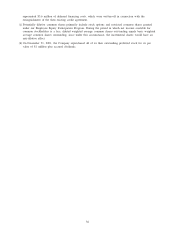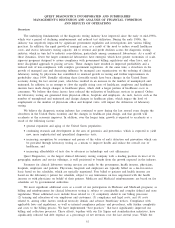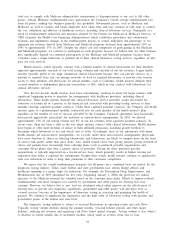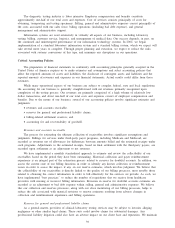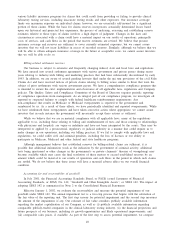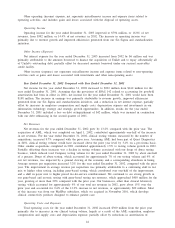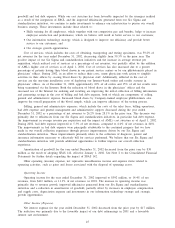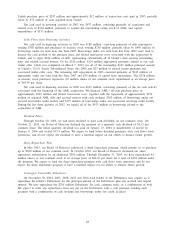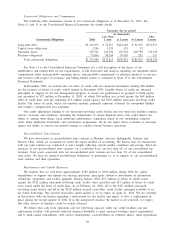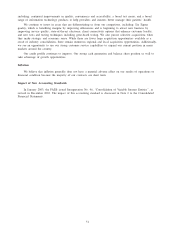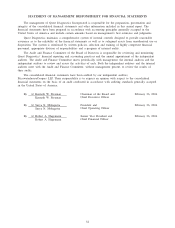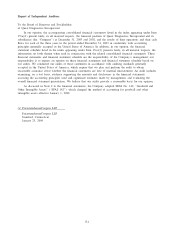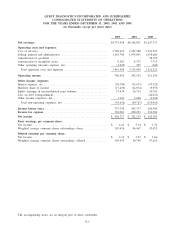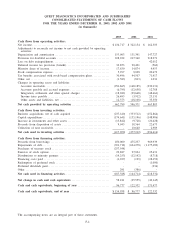Quest Diagnostics 2003 Annual Report Download - page 63
Download and view the complete annual report
Please find page 63 of the 2003 Quest Diagnostics annual report below. You can navigate through the pages in the report by either clicking on the pages listed below, or by using the keyword search tool below to find specific information within the annual report.In 2001, we refinanced a majority of our long-term debt on a senior unsecured basis. Specifically, we
completed a $550 million senior notes offering, or the Senior Notes, and entered into a new $500 million
senior unsecured credit facility, or the Credit Agreement, which included a five-year $325 million revolving
credit agreement and a $175 million term loan. We used the net proceeds from the senior notes offering and
the term loan, together with cash on hand, to repay all of the $584 million which was outstanding under our
then existing senior secured credit agreement, including the costs to settle existing interest rate swap agreements,
and to consummate a cash tender offer of our 10
3
⁄
4
% senior subordinated notes due 2006, or the Subordinated
Notes. In conjunction with our debt refinancing, we recorded a loss on debt extinguishment of $42 million, $36
million of which represented the write-off of $23 million of deferred financing costs, associated with the debt
which was refinanced, and $13 million of payments related primarily to the tender premium incurred in
connection with our cash tender offer for our Subordinated Notes. The remaining $6 million of losses
represented amounts incurred in conjunction with the cancellation of certain interest rate swap agreements,
which were terminated in connection with the debt that was refinanced. Prior to our debt refinancing, our
secured credit agreement required us to maintain interest rate swap agreements to mitigate the risk of changes
in interest rates associated with a portion of our variable interest rate indebtedness.
Other income (expense), net, represents miscellaneous income and expense items related to non-operating
activities, such as gains and losses associated with investments and other non-operating assets. For the year
ended December 31, 2002, other income (expense), net includes a $4.9 million pretax gain on the sale of
certain assets, partially offset by losses on miscellaneous non-operating assets. For the year ended December 31,
2001, other income (expense), net includes the net impact of writing-off $9.6 million of certain impaired assets,
partially offset by a $6.3 million gain on the sale of an investment.
Income Taxes
During 2001, our effective tax rate was significantly impacted by goodwill amortization, the majority of
which was not deductible for tax purposes, and had the effect of increasing the overall tax rate. The reduction
in the effective tax rate for the year ended December 31, 2002 was primarily due to the elimination of
amortization of goodwill (as a result of adopting SFAS 142, effective January 1, 2002) the majority of which
was not deductible for tax purposes.
Impact of Contingent Convertible Debentures on Diluted Earnings per Common Share
On November 26, 2001, we completed our $250 million offering of 1
3
⁄
4
% contingent convertible debentures
due 2021, or the Debentures. Each one thousand dollar principal amount of Debentures is convertible into
11.429 shares of our common stock, which represents an initial conversion price of $87.50 per share. Holders
may surrender the Debentures for conversion into shares of our common stock under any of the following
circumstances: (i) if the sales price of our common stock is above 120% of the conversion price (or $105 per
share) for specified periods; (ii) if we call the Debentures; or (iii) if specified corporate transactions have
occurred. See Note 11 to the Consolidated Financial Statements for a further discussion of the Debentures.
The if-converted method is used in determining the dilutive effect of the Debentures in periods when the
holders of such securities are permitted to exercise their conversion rights. As of and for each of the years
ended December 31, 2003 and 2002, the holders of our Debentures did not have the ability to exercise their
conversion rights. Had the requirements to allow the holders to exercise their conversion rights been met and
the Debentures remained outstanding for the entire period, diluted earnings per common share would have been
reduced by approximately 2% during each of the years ended December 31, 2003 and 2002.
Quantitative and Qualitative Disclosures About Market Risk
We address our exposure to market risks, principally the market risk of changes in interest rates, through a
controlled program of risk management that may include the use of derivative financial instruments. We do not
hold or issue derivative financial instruments for trading purposes. We do not believe that our foreign exchange
exposure is material to our financial position or results of operations. See Note 2 to the Consolidated Financial
Statements for additional discussion of our financial instruments and hedging activities.
At December 31, 2003 and 2002, the fair value of our debt was estimated at $1.2 billion and $899
million, respectively, using quoted market prices and yields for the same or similar types of borrowings, taking
into account the underlying terms of the debt instruments. At December 31, 2003 and 2002, the estimated fair
value exceeded the carrying value of the debt by approximately $86 million and $77 million, respectively. An
46


